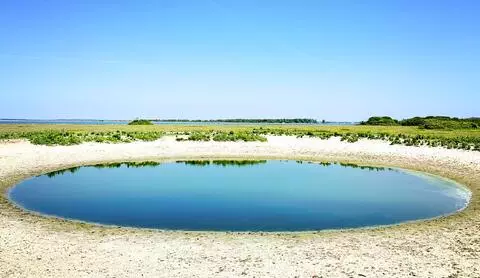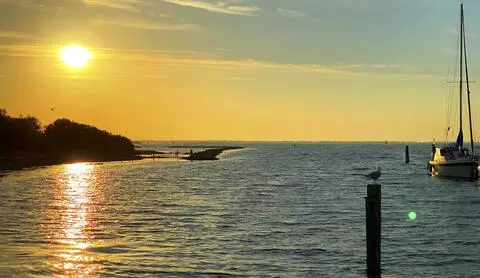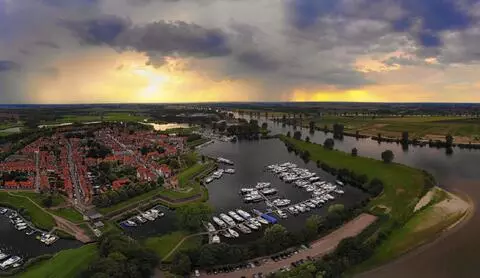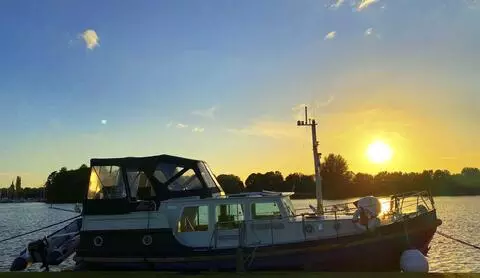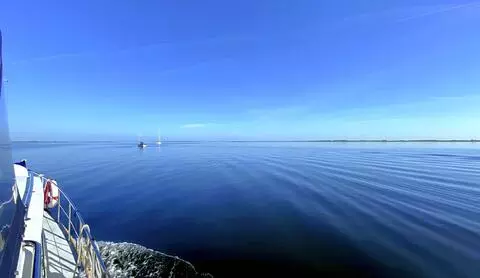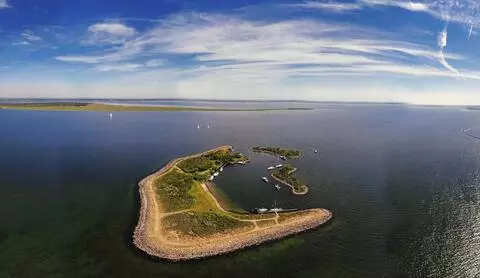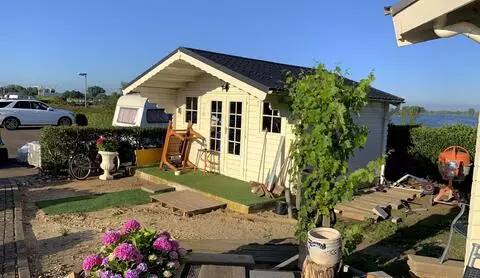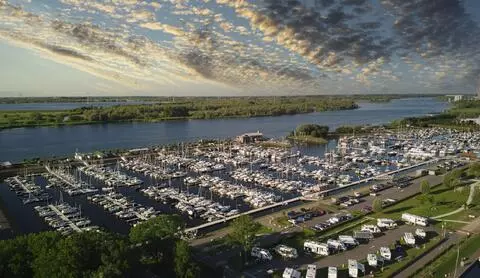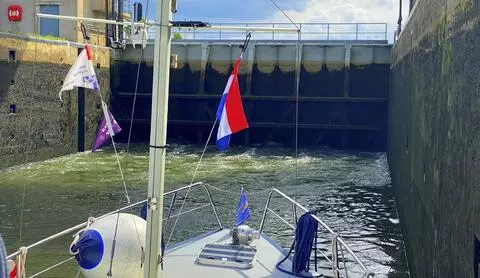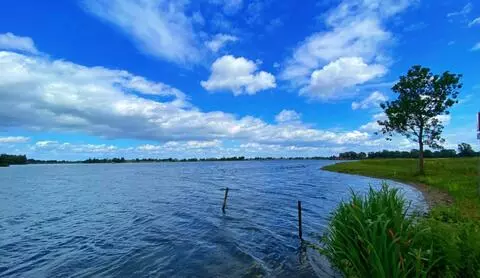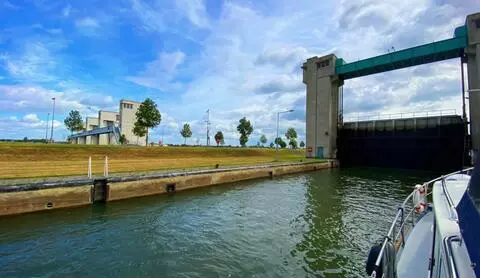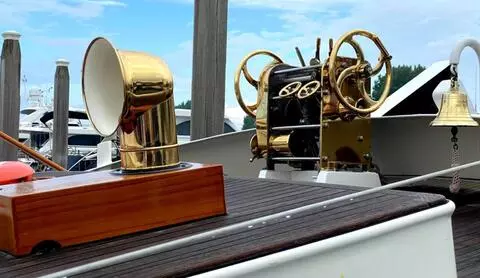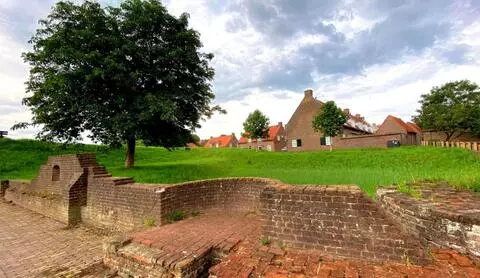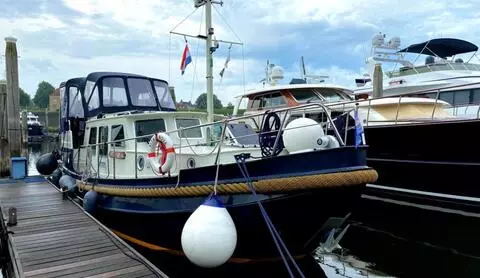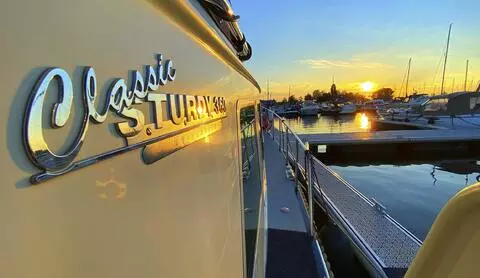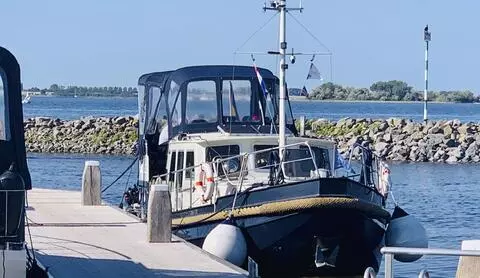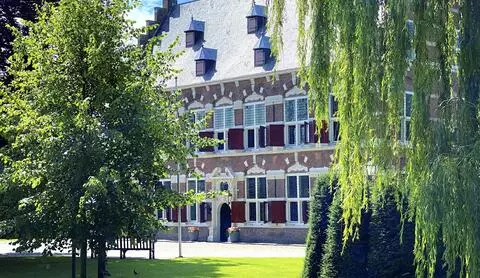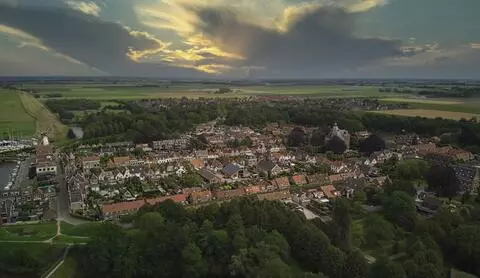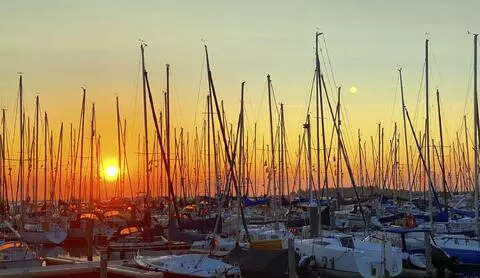Summer cruise 2020 - After the very late start of the season we wanted to really enjoy our summer cruise. As well as transferring to our new home port, we took a trip to the Grevelingenmeer and spent many pleasant hours on the water. It’s a cruise report that will inspire you to follow in our wake, I promise.
Before the sailing fun, Neptune (or was it Poseidon?) set out our work for us. We had to provision Vita Nova for the trip. Fresh food and drink were stowed away just before the start of the cruise, and 370 litres of water were pumped into the tanks, so that we could wash up and also have a shower or two on the way. The two diesel tanks were each about 75-80 litres short. We would top them up once we were underway.
We’d been flirting with the idea of getting new deck chairs for some time. And the time was just right, so we quickly drove to the Kampeer Oase in Elst to buy new chairs for the cockpit. We decided on the Crespo Air Deluxe.
We have the latest digital map material on four devices (iPad Air2, iPad Pro, 2x iPhone) to ensure reliability. As we were setting off on the cruise, we had no idea just how important the map material would turn out to be. We had been using the Navionics “Boating” app for many years. We really appreciated its functionalities, the daily updates and the community edits. We’ve already written an article about it.
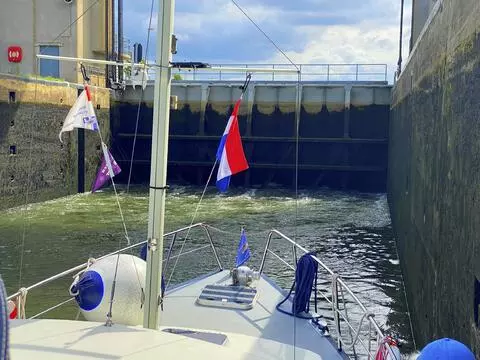
Day 1:
We cast off from our home port of `t Loo in Linden at 7:30 on 19 June 2020, as we were keen to get to know new ports and the Grevelingenmeer. Being “early birds”, we love to get underway promptly. The waterways were wonderfully empty and we were left alone to enjoy the silence and the countryside for some time.
Comfortably and quietly the Volvo Penta pushed us through the Kraaijenbergse Plassen towards the Meuse. We turned to port on to the Meuse at kilometre 167.
We were already quite familiar with the Meuse in this area from our Roermond - Biesbosch cruise. Kilometres 167 to 176 on the river were fun and the joy of cruising was unbounded. At KM 176 we came to the first lock of the day. Grave lock. They can be contacted via VHF channel 20 or by telephone on 0031-88 797 4142. We duly reported in properly shortly before reaching the lock harbour. Due to poor voice quality, no exchange was possible. We moored at the leisure craft jetty in the outer harbour and waited.
A commercial vessel came out of the lock. The traffic light was and stayed red, and the lock gate closed again. After another inquiry at the lock, communication improved. The commercial vessels were bumper-to-bumper in the tailwater so the lock was emptying quickly. After an hour and a half we sailed the Vita Nova out of the lock in the tailwater. Now we had a few kilometres of free motoring in which to enjoy the Meuse and the surrounding countryside. Time and again we had to stay alert when we passed one of the many ferries. It can sometimes seem as if the ferries are waiting for you to get close up and then set off. Whatever, as Michael Wendler would sing.
We passed Niftrik and De Gouden Ham in Maasbommel and called ahead shortly before reaching the outer harbour of Prinses Maxima lock (VHF channel 22 or telephone 0031-88 7944135) at kilometre 200 for the downhill lock. A commercial vessel came out and we were able to sail right in without waiting. It went like clockwork.
Now we had only about four kilometres to get to the jetty in De Lithse Ham marina. We moored at the registration jetty and then moved the Vita Nova into Box 46. It had been a leisurely and relaxing day’s cruising.
Now the ship’s dog was allowed out and afterwards the crew got something to eat.
Statistics:
Distance travelled: 42 km | Locks: 2 | Engine hours: 4
We paid €18.45 for one night (boat size: 11 m x 3.6 m).
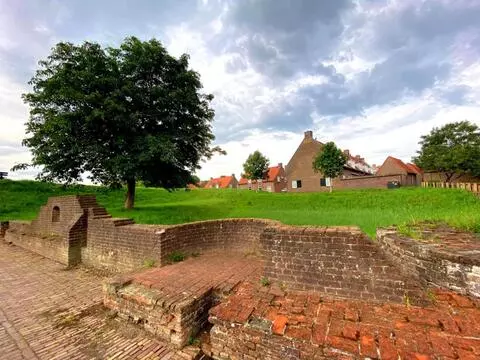
Day 2:
What a day – more eventful than expected.
Cast off at 7:30 from De Lithse Ham marina. The harbour is OK for an overnight stay. That’s all you need. Although the marina is in a beautiful location, it has no real ambiance. Although there were a few boats at the jetties, the place looked half dead.
Today we had planned to cover about 47 kilometres and arrive at a convenient jetty in Aakvlaai or Biesbosch. Apart from a few encounters with ferries, cruising down the Meuse to the Amer was again quite leisurely and relaxing. As we had made good time, we were looking forward to getting to the jetty early. We know the area (Biesbosch/Aakvlaai) from 2016, when we had an annual berth there. It must have been due to the circumstances (Corona, weather, etc.), but it was much busier than usual. There was no suitable berth to be had for the Vita Nova in Aakvlaai. Most of the best jetties were no longer available, which further reduced the number of berthing options.
So we left Aakvlaai and went back into the Biesbosch, where we also knew two or three great moorings. How could it be otherwise, they were all occupied too. An excursion boat followed in our wake. We waited until we reached a suitable spot and then let it pass. The draft of the Vita Nova (1.10 m) is close to the limit for the Biesbosch. As anyone familiar with the area knows... it’s a freshwater tidal area and a difference in level of 20-30 cm is normal there. If you have 40 cm! (0.4 m) water under the keel as you sail along, you ought to know the area and its peculiarities!
Thanks to our rather outdated knowledge of the area and up-to-date maps from Navionics, we made it through the entire Biesbosch without touching the bottom. As already mentioned at the beginning of the cruise report, you can have problems in the Biesbosch if your maps aren’t up to date! We’re glad to report that we came through safely thanks to the daily sonar chart updates provided by Navionics! As we didn’t want to drop anchor, we decided to sail right through the Biesbosch, turn to port on to the Amer at Hollandsch Diep and call at our 2016 home port. The journey through Aakvlaai and Biesbosch extended the planned stage by 27 kilometres and three hours’ sailing. Sometimes it’s worth leaving even earlier.
We moored in the Biesbosch Drimmelen marina at 14:10, where jetty neighbours helped us to tie up. The marina had also been hospitable and well organised back in 2016.
Now the ship’s dog was the first one off to lift his leg while the crew took care of the formalities in the new harbourmaster’s office.
Statistics:
Distance travelled: 76 km | Locks: 0 | Engine hours: 7,5 h
We paid €26.00 for one night (boat size: 11 m x 3.6 m).
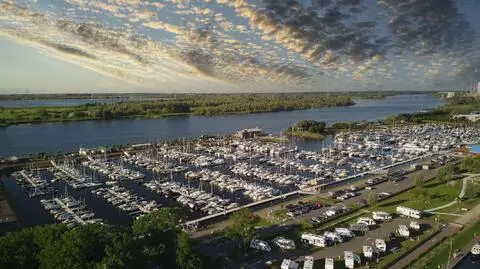
Day 3:
Yesterday we were treated to a great sunset in the Biesbosch marina. It had been a quiet night and we cast off the lines as the sun was rising over the Biesbosch. We sailed along the Amer under the Moerdijk bridges to the Hollandsch Diep and on to Willemstad. The Hollandsch Diep separates North Brabant from South Holland and is about two kilometres wide. Some commercial vessels were around but, due to the vastness of the Hollandsch Diep, it was a very leisurely journey. Especially since two extremely generous stretches of water are set aside for leisure craft.
It was a leisurely day’s cruising. We were sailing from 7:35 to 10:10, covering just under 30 kilometres. We then settled into the “De Batterij” marina at jetty G-14, which we had already reserved by phone the day before. That worked out wonderfully.
We completed the administrative procedures in the marina and enjoyed the rest of the day. But we also take time to take pictures of Willemstad. We had been tipped off that we should definitely call at Willemstad on our trip. That was a really good tip. Willemstad is a beautiful town and a pleasant place to stroll and linger. From the marina you can reach the town in under 10 minutes. If you’re in the town harbour, it’s only five steps up to the promenade with shops and a few restaurants. We walked once completely around the town (3.4 km) and then settled down in a restaurant at the harbour. The harbour appears to be a very popular meeting place. Many motorcyclists had parked their motorcycles there in order to fortify themselves on their tour as well.
Statistics:
Distance travelled: 15 km | Locks: 0 | Engine hours: 2,6 h
We paid €25.29 for one night (boat size: 11 m x 3.6 m).
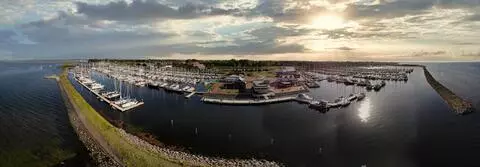
Day 4:
Willemstad to Bruinisse
We cast off from the De Batterij marina shortly after 7:00. We wanted to leave early again to get through the locks. All three locks have special sections for leisure craft. Calling ahead by radio worked great.
In front of the Volkerak lock, we met the Linssen Grand Sturdy 460 - Quincy. As we had the same destination for the day, we decided to travel together.
The short ride from Willemstad via the Hollandsch Diep was quick and easy. We had to wait 20 minutes in front of the Volkerak lock.
The locks (all three!) were easy to handle and thanks to the small lift they were always completed in 15 minutes (pure lock time). Coming from Willemstad, the Volkerak and Krammer locks sluice downhill and the Grevelingen lock then runs uphill.
Cruising in the Volkerak was leisurely and was similar to the part of the IJsselmeer that comes before Lemmer. There were many wind turbines and a lot of water, wonderful. The fairways are so wide that commercial vessels and leisure craft don’t get in each other’s way. Great! We were lucky with the weather too. The water and the sky were equally blue. Really beautiful.
The crew of the Quincy had a moment of shock. An OK steel displacement yacht cut the Quincy up so close that it would have crashed into the rear of the displacement yacht if it had not fully stopped. Totally unimpressed by blasts of the horn and the near collision, the steel displacement yacht continued on its way. Incredible and really a close-run thing.
If any of you encounter this displacement yacht, be very careful!
In the Krammer and Grevelingen locks, things got a bit busier, with 7-10 boats passing through at the same time. You notice straight away when the lock gate opens and you have salt water under the keel. The smell is unmistakable.
Only a few hundred metres after leaving the Grevelingen lock we turned to port together with the Quincy into the Bruinisse marina. Both Linssens had been given a place at the registration jetty and were allowed to stay there overnight.
All I can say about Bruinisse marina is that it’s really big and well equipped. Sheer poetry! The sanitary building was new and was very well maintained. It had showers with hand basin and mirror and plenty of space.
In the marina we also got the sticker that allowed us to moor at the vacant berths in the Grevelingenmeer (€12.50 per week).
After Day 6 you will find many answers to questions about the Grevelingenmeer itself, which we were asked during the trip.
As our fresh food was slowly running out, we decided to visit the nearby Albert Heijn supermarket on our e-scooters. It’s only 1.8 kilometres from the marina. So we drove the route twice and, in addition to the fresh food, we also stowed away 45 litres of fresh water. This worked really well with the e-scooters.
Early the next morning (but not sooo early), we would fill the water and diesel tanks.
Then we would be off to the Grevelingenmeer.
Statistics:
Distance travelled: 29 km | Locks: 3 | Engine hours: 3,2 h
We paid €32.29 for one night (boat size: 11 m x 3.6 m).
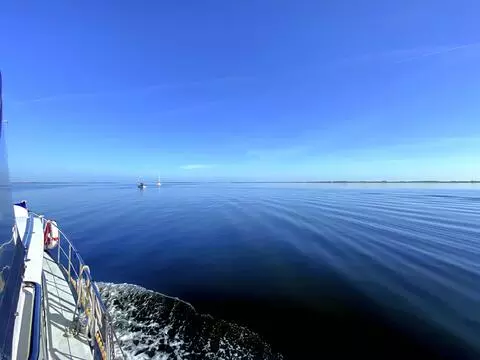
Day 5:
We started the day at 8:00 by filling the fresh water tanks and hauling the Vita Nova 50 metres to the filling station, which is located right next to the registration jetty in front of the harbour office. We have two 250-litre diesel tanks (a total of 500 litres), and had already used up an estimated 200 litres on our trip. We told the harbourmaster to fill her up.
Result: two spills, diesel on the gangway and a lot of rags used. We filled up with 178.51 litres at €1.24 per litre, making a total of €221.35.
As of that day, we would be in the Grevelingenmeer for one week. It’s the largest salt-water lake in Europe. Our first port of call was at “Dwars in Den Weg” island near Stampersplaat, virtually opposite the Brouwershaven, and just under 14 kilometres from Bruinisse marina and one of the southernmost ports of call in the Grevelingenmeer. You can berth on the inside (cleats) and outside (wooden posts) of the jetty. Water depth is about 3 metres. The jetty leads ashore, so it was ideal for the ship’s dog. Waste bins are also provided. The journey from Bruinisse to Dwars in Den Weg was leisurely and made for some great photography. Our Mavic Air drone was also in the air again. We enjoyed the day and we would see how long we would stuck around.
Basically, we would still be calling at the Brouwersdam at Port Zélande and the archipelago, as we had plenty of time.
Statistics:
Distance travelled: 8 km | Locks: 0 | Engine hours: 1,3 h
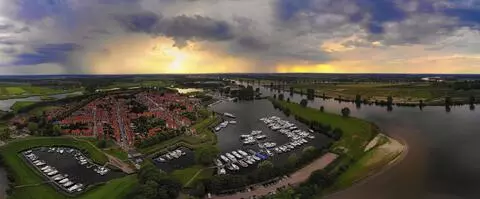
Day 6:
The Vita Nova moved on. From “Dwars in Den Weg,” we entered the Grevelingen Archipelago. Only about eight kilometres (through the safe fairway) separate the two moorings.
So our trip only took about 43 minutes. As we had been given a fantastic berth, we intended to make full use of the three days we were allowed to moor there. We then headed to the far west of the Grevelingenmeer. We head for one of the two natural harbours and anchorages at the Brouwersdam. They are located in the immediate vicinity of Port Zélande and Renesse.
Statistics:
Distance travelled: 9 km | Locks: 0 | Engine hours: 0,8 h
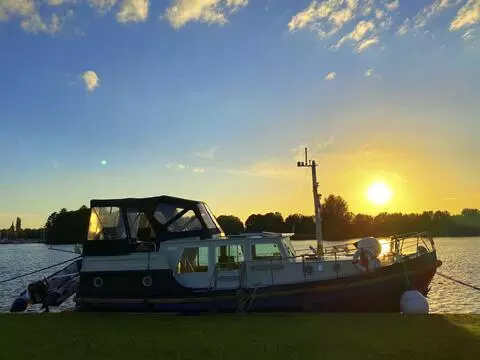
Day 7:
Nothing is as constant as change. And this is especially true of the weather. Actually, we wanted to stay two more days in the archipelago. But then the storm that had been forecast changed our plans. We didn’t want to experience rain, thunderstorms and gusts of wind up to 50 km/h unprotected In an unknown area.
The lovely weather... 28-32 degrees. Sun-soaked. But as every skipper knows... nothing lasts for ever ♂️ – the weekend was set to bring thunderstorms and a lot of wind. In gusts of up to 50 km/h. Especially around Scharendijke it was forecast to be extremely and continuously windy. Otherwise, it would be blowing hard on the Grevelingenmeer and also the Hollandsch Diep. It was set to be very windy until Tuesday, 30 June 2020.
We therefore rescheduled our plans. The Vita Nova left the archipelago and set off for the Brouwersdam/Scharendijke. Unfortunately, the two natural jetties were full up. Boats were even rafting up. Neither was there any more space to be had in the beautifully situated “Haven aan de Middelplaat” marina. Too bad – about the location. The marina itself is tiny and hardly worth a visit.
When we moored in Bruinisse marina again, a large yacht was just leaving:
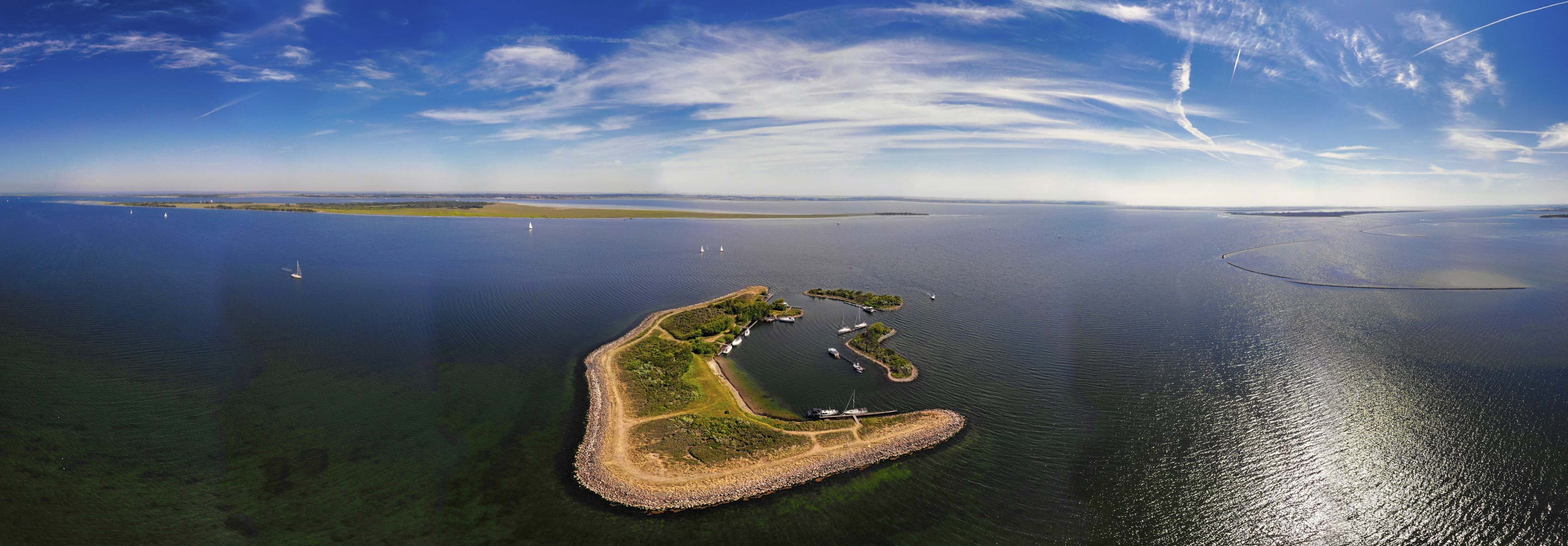
Statistics:
Distance travelled: 27 km | Locks: 0 | Engine hours: 1,9 h
Once again we paid €32.29 for one night.
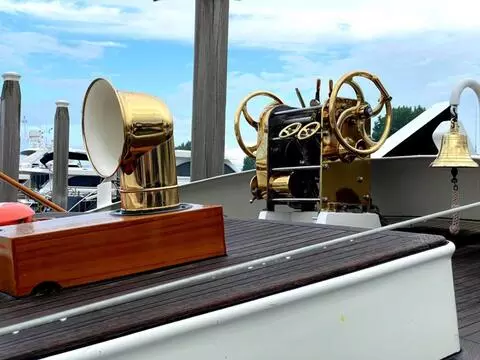
Day 8:
Bruinisse to Heusden
The previous evening we had been treated to a beautiful sunset, which we would like to share with you.
That day, as planned, we made good progress. The Vita Nova got 81.3 kilometres under its keel in just under eight and a quarter hours, including three locks: Grevelingen, Krammer, and Volkerak.
We set off with a beautiful sunrise at 6:45. Only 20 minutes later we were registering at the first lock (Grevelingen). That day, passing through all three locks was very smooth and easy.
We sailed from Bruinisse to Krammer lock via Noorder Slaak and Krammer. It took about 20 minutes.
We had hardly got through the yacht lock when we were on Noord-Krammer and turned starboard towards Zuid-Vlije.
We then sailed through the Hellegat fairway to Volkerak yacht lock via Volkerak. It took us a leisurely and peaceful two hours.
Coming out on to the Hollandsch Diep, we passed the Willemstad marina on the starboard side. As always, our early departure paid off. With a few exceptions, we were almost alone on the fairways. Added to that were the morning light and the expanse of water... just perfect.
A couple of commercial vessels then appeared at the Moerdijk bridges, but that’s all.
It wasn’t until we were off Biesbosch/Aakvlaai and Drimmelen that the number of pleasure craft began to increase rapidly.
Hardly surprising... it was Friday afternoon and we were having great weather.
The fact that virtually nobody adhered to the speed limits to avoid wakes and swell but regarded them as recommendations that needn’t be followed, made us a little annoyed. Shaking our heads, we accepted the conditions. What else can you do?
We continued our journey via the Amer to the Bergsche Maas canal.
No matter whether in front of harbours or ferries, the jet skis and speedboats were going as fast as their engines would allow.
A trend that really makes us think.
But it’s not only the riders of glider yachts who should perhaps be retaught the effect on wave propagation.
This displacement yacht travelled for kilometres like this. It’s really difficult to understand why. No commercial vessel that we encountered along the way produced a stern wave this big. What goes on in these people’s heads?
But we were making good progress with all that variety around.
It was well over 30 degrees when we reached our destination, the De Wiel marina in Heusden, a little drained as a result of the long boat ride.
Nevertheless, mooring at the jetty in box G-4 went well and, after phoning to make an appointment, we visited the harbourmaster’s office in order to be seen personally.
We covered the distance that day because, as already mentioned in another post, we would rather weather the rain and the thunderstorm a bit further inland. Furthermore, we’d never visited Heusden before and wanted to follow up some recommendations from our boating friends.
First we have to say that Heusden is a great little town. Taking the ship’s dog for a walk, shopping in small craft shops and eating delicious food. Everything was great. Heusden’s small harbour is the perfect place for these activities! However, overnight stays aren’t allowed there. You can moor, stroll, get something to eat or let the ship’s dog out without any problems.
Only the De Wiel marina made a less favourable impression.
With a thunderstorm approaching, it was the perfect opportunity to send the drone aloft. Unfortunately I was a little bit inattentive and didn’t launch the drone from the De Wiel marina but, as it turned out during the landing, from private property. The owner was, rightly, not particularly pleased. But we were able to explain everything and an apology settled the matter.
Statistics:
Distance travelled: 82,1 km | Locks: 3 | Engine hours: 8 h
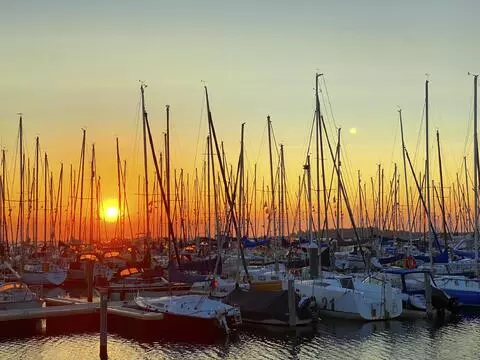
Day 9:
We fitted in a scheduled day in port. A few impressions of the De Wiel marina in Heusden: For us, the old harbour (you pass under the white bascule bridge) had more charm than the new marina. This might be because you hardly see a thing by walking over the jetties, as the huge yachts have such a freeboard there that you can’t see anything for the paint, stems and swimming platforms. There were some really nice yachts there, no question. From classic to ultramodern. How practical they would be on a cruise at over 20m in length, I can’t say. There are few marinas that have transit jetties for yachts of this size.
The area around the marina was very well maintained. Weather permitting, we intended to take a tour of Heusden that day. If we got a smart card that worked. Unfortunately, the first two smart cards didn’t let us back on to the jetty.
Statistics:
Distance travelled: 38,1 km | Locks: 1 | Engine hours: 3,7 h
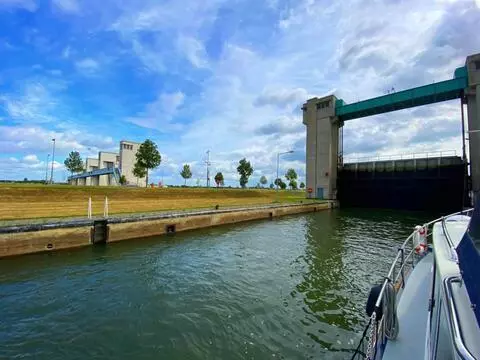
Day 10:
De Wiel marina, Heusden to De Gouden Ham marina, Maasbommel
We cast off from De Wiel marina in Heusden at 8:00. Our destination for the day was De Gouden Ham near Maasbommel. The trip covered 38 kilometres, including one lock. The weather was mixed until we moored at De Gouden Ham. It was dry, but windy and cloudy.
We passed through the Prinses Maxima lock in 20 minutes. Calling ahead on VHF channel 22 posed no problems.
We were back at the berth almost to the day (2 July) that we visited on our glider yacht in 2015. It was great to be back.
The harbourmaster came round to collect the mooring fees in the evening. In De Gouden Ham electricity, toilets and showers are provided at the berths with jetties. We moored a little further forward because we didn’t need electricity.
Our solar panels provide enough electricity even on cloudy days so we can be self-sufficient. For the ship’s dog there’s nothing better. Our berth had a view of the Meuse and De Gouden Ham. Perfect.
After mooring, we unpacked our e-scooters and drove once around De Gouden Ham and back to refresh our fond memories.
We made ourselves comfortable at this berth. We probably wouldn’t be setting sail until Tuesday to make the last leg of the journey to our home port.
We took a look under the floorboards in the bilge again and sorted out a few minor issues ourselves. There was no engine oil in the bilge. The seawater filter was clean. Our small plastic bowl under the shaft stuffing box was two-thirds full. This is normal for the number of operating hours run. We tipped the water/grease mixture into a bottle, which we always have on board for “waste to be disposed of”. The shaft also got another rotation from the grease reservoir. OK!
Maybe some information would help... we empty the small plastic bowl (holds 150-180 ml) about every 40-50 operating hours.
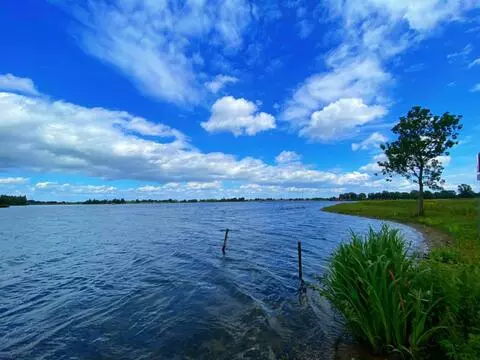
Day 11:
We stayed another day in Maasbommel. We liked it a lot there. An overnight stay costs €12 for boats up to 10 metres and €17 for boats over 10 metres.
Someone comes to collect at about 18:00 every evening. Payments are only possible by EC-Cash and entering a PIN code.
At the back, there are 125 more berths at jetties with electricity and showers are also available. No difference in price, but busier.
The nice thing about this berth was that you had a direct view of the Meuse and also of De Gouden Ham itself. Great.
The wind got up in the evening and was blowing at well over 50 km/h. We have positioned the mooring lines and fenders perfectly. No problems were therefore expected.
Other boats came and went throughout the day. We helped some with mooring and others with casting off. It’s a point of honour.
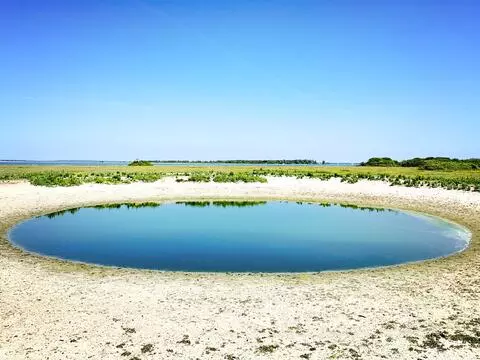
Day 12:
We had spent the previous two days at the natural jetty in De Gouden Ham, Maasbommel. The lovely weather again meant that we could move on. We took our final daily stage at a very leisurely pace. It took us only about two and a half hours to get from Maasbommel (kilometre 192 on the Meuse) to the entrance to ‘t Loo in Linden (kilometre 167), despite Grave lock.
We were lucky enough to be able to enter Grave lock with the inland vessel “Tamaris”. In this way, we passed through the lock, a process which had taken us a good one and a half hours on the outward journey, in 18 minutes. It’s not possible to give details of timings as far as locks are concerned. Once again, our “Grave example” very clearly shows why.
Statistics:
Distance travelled: 28 km | Locks: 1 | Engine hours: 2,5 h
Overall statistics
Distance travelled: 354,80 km
Locks: 10
Engine hours: 35,5 h
Total travel time: 39 hours, 14 minutes
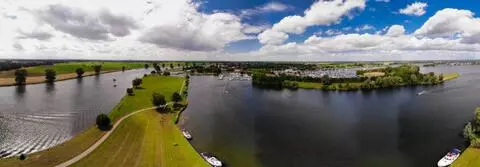
Day 10:
De Wiel marina, Heusden to De Gouden Ham marina, Maasbommel
We cast off from De Wiel marina in Heusden at 8:00. Our destination for the day was De Gouden Ham near Maasbommel. The trip covered 38 kilometres, including one lock. The weather was mixed until we moored at De Gouden Ham. It was dry, but windy and cloudy.
We passed through the Prinses Maxima lock in 20 minutes. Calling ahead on VHF channel 22 posed no problems.
We were back at the berth almost to the day (2 July) that we visited on our glider yacht in 2015. It was great to be back.
The harbourmaster came round to collect the mooring fees in the evening. In De Gouden Ham electricity, toilets and showers are provided at the berths with jetties. We moored a little further forward because we didn’t need electricity.
Our solar panels provide enough electricity even on cloudy days so we can be self-sufficient. For the ship’s dog there’s nothing better. Our berth had a view of the Meuse and De Gouden Ham. Perfect.
After mooring, we unpacked our e-scooters and drove once around De Gouden Ham and back to refresh our fond memories.
We made ourselves comfortable at this berth. We probably wouldn’t be setting sail until Tuesday to make the last leg of the journey to our home port.
We took a look under the floorboards in the bilge again and sorted out a few minor issues ourselves. There was no engine oil in the bilge. The seawater filter was clean. Our small plastic bowl under the shaft stuffing box was two-thirds full. This is normal for the number of operating hours run. We tipped the water/grease mixture into a bottle, which we always have on board for “waste to be disposed of”. The shaft also got another rotation from the grease reservoir. OK!
Maybe some information would help... we empty the small plastic bowl (holds 150-180 ml) about every 40-50 operating hours.
Day 11:
We stayed another day in Maasbommel. We liked it a lot there. An overnight stay costs €12 for boats up to 10 metres and €17 for boats over 10 metres.
Someone comes to collect at about 18:00 every evening. Payments are only possible by EC-Cash and entering a PIN code.
At the back, there are 125 more berths at jetties with electricity and showers are also available. No difference in price, but busier.
The nice thing about this berth was that you had a direct view of the Meuse and also of De Gouden Ham itself. Great.
The wind got up in the evening and was blowing at well over 50 km/h. We have positioned the mooring lines and fenders perfectly. No problems were therefore expected.
Other boats came and went throughout the day. We helped some with mooring and others with casting off. It’s a point of honour.
Day 12:
We had spent the previous two days at the natural jetty in De Gouden Ham, Maasbommel. The lovely weather again meant that we could move on. We took our final daily stage at a very leisurely pace. It took us only about two and a half hours to get from Maasbommel (kilometre 192 on the Meuse) to the entrance to ‘t Loo in Linden (kilometre 167), despite Grave lock.
We were lucky enough to be able to enter Grave lock with the inland vessel “Tamaris”. In this way, we passed through the lock, a process which had taken us a good one and a half hours on the outward journey, in 18 minutes. It’s not possible to give details of timings as far as locks are concerned. Once again, our “Grave example” very clearly shows why.
Statistics:
Distance travelled: 28 km | Locks: 1 | Engine hours: 2,5 h
Overall statistics
Distance travelled: 354,80 km
Locks: 10
Engine hours: 35,5 h
Total travel time: 39 hours, 14 minutes

